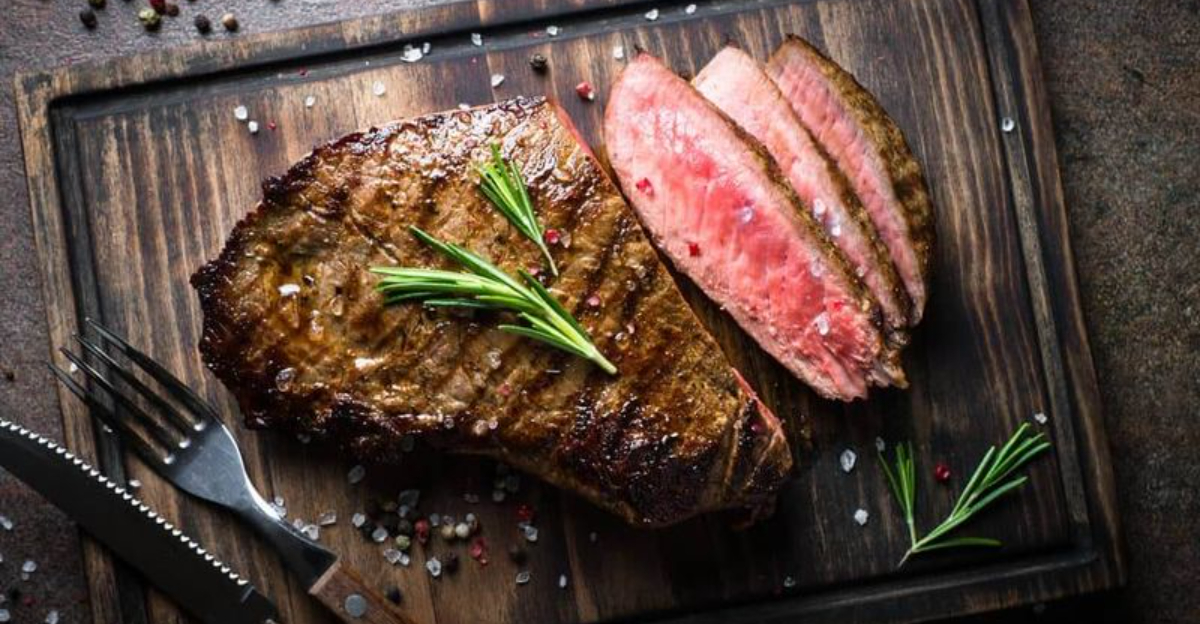15 Ribeye Steak Facts Every Meat Lover Should Know

Ribeye isn’t just another steak on the menu. It’s the rich, juicy centerpiece that makes carnivores weak in the knees.
Known for its marbling, bold flavor, and melt-in-your-mouth texture, the ribeye has a fan club all its own. But there’s more to this iconic cut than just sizzle and sear.
From butcher secrets to cooking tips and beefy trivia, there’s a whole world behind that perfect bite. Get ready to beef up your steak smarts.
1. The Name Game
Ribeyes go by many aliases across the globe. In Australia, you’ll hear folks ordering a “Scotch fillet,” while fancy restaurants might list it as a “Delmonico steak” on their menus.
These regional nicknames all refer to the same delicious cut. The multiple identities developed as butchers in different countries established their own terminology for this premium meat.
2. Prime Real Estate
Butchers harvest ribeyes from a specific section of the cow between the 6th and 12th ribs. This location is no accident – it’s a muscle area that doesn’t get much exercise.
Less movement means more tenderness and flavor. The position along the rib cage allows the perfect balance of fat development while maintaining the meat’s structural integrity and creating that signature taste.
3. Fat Equals Flavor
Those beautiful white streaks running through your ribeye aren’t flaws – they’re flavor highways! Marbling refers to the intramuscular fat distributed throughout the meat.
When cooked, these fat deposits melt and baste the steak from within. The more abundant and evenly distributed the marbling, the more succulent and flavorful your steak will be.
4. Bone Decision
Choosing between bone-in and boneless ribeye isn’t just about presentation.
Bone-in cuts (called rib steaks) typically cook more evenly because the bone acts as an insulator, preventing that side from cooking too quickly.
Many chefs swear the bone adds flavor, though science suggests this effect is minimal. Boneless ribeyes offer easier carving and more consistent cooking for beginners.
5. Crown Jewel
Hidden within every ribeye lies a special treasure: the spinalis dorsi, commonly called the rib cap or ribeye cap. This crescent-shaped muscle wraps around the outside of the ribeye.
Chefs consider it the single most flavorful muscle on the entire cow. Rich with marbling yet tender as butter, this section delivers an intensity of beef flavor that makes steak lovers swoon.
6. Grade A Information
Wonder why some ribeyes cost twice as much as others? Look to the grading system. USDA Prime represents the top tier, featuring abundant marbling and accounting for less than 3% of all beef.
Choice grades offer good marbling at more accessible prices. Select cuts, with minimal marbling, might disappoint true ribeye enthusiasts.
Japanese Wagyu ribeyes with their extraordinary marbling often command prices exceeding $100 per pound!
7. Aged to Perfection
Dry-aging transforms good ribeyes into transcendent experiences. During this process, steaks rest in temperature-controlled environments for weeks while natural enzymes break down muscle fibers.
Water evaporates, concentrating flavors and creating new compounds that deliver nutty, funky notes.
Premium steakhouses often feature 28-day or 45-day aged ribeyes for those seeking the ultimate beef experience.
8. Heat Meets Meat
Ribeyes shine brightest when cooked with high heat methods. Grilling over charcoal imparts smoky notes that complement the rich fat, while cast iron searing creates the perfect crust through the Maillard reaction.
Avoid the temptation to use wet cooking methods like braising. The high fat content makes ribeyes ideal candidates for simple cooking approaches that let their natural flavors take center stage.
9. Temperature Target
Forget well-done ribeyes! This premium cut reaches its flavor peak at medium-rare (130-135°F). The USDA recommends a minimum internal temperature of 145°F for safety, which is medium.
Cooking beyond medium causes the abundant fat to render out completely, leaving you with a dry, less flavorful experience. Invest in a good meat thermometer to nail the perfect temperature every time.
10. Fat Comparison
Ribeyes contain substantially more fat than their leaner cousin, the New York strip. While a strip steak typically contains 10-15% fat, ribeyes boast a luxurious 20-30% fat content.
This extra fat translates directly to flavor and juiciness. Health-conscious diners might prefer strips, but true flavor seekers gravitate toward the ribeye’s richer profile and more forgiving cooking properties.
11. Weighty Matters
Fat content significantly impacts the weight of your ribeye. Nearly one-third of a ribeye’s total weight comes from fat, not protein. This composition explains both its heavenly flavor and higher calorie count.
A typical 16-ounce ribeye delivers approximately 1,100 calories. The good news?
You’re getting complete protein with all essential amino acids, plus beneficial nutrients like iron, zinc, and B vitamins.
12. Time Transforms Taste
Patience pays off when dry-aging ribeyes. The magic begins around 21 days when enzymes have sufficiently broken down muscle fibers for increased tenderness.
By 28 days, distinctive nutty flavors develop. True connoisseurs seek 45-day aged cuts for their intense, almost blue cheese-like complexity.
Beyond 60 days, steaks develop funky, gamy notes that may overwhelm casual steak eaters.
13. Thickness Matters
Grocery store ribeyes often disappoint at a skinny ¾-inch thickness. For transcendent steak experiences, seek cuts at least 1.5 inches thick – the standard at quality steakhouses.
Thicker steaks allow for proper searing without overcooking the center. They also provide the perfect canvas for developing temperature gradients, with a crusty exterior giving way to a warm, pink center.
14. The Resting Period
Cutting into a ribeye straight off the heat is a rookie mistake! Resting allows juices to redistribute throughout the meat instead of spilling onto your plate.
Five minutes suffices for standard cuts, while thicker steaks benefit from 10 minutes under loose foil. During this time, carryover cooking continues, raising the internal temperature by about 5 degrees.
15. America’s Favorite
Ribeyes consistently rank in America’s top three most popular steaks, battling filet mignon and strip steaks for supremacy. Steakhouse sales data shows ribeyes often outsell other cuts during economic upswings.
Their popularity spans demographics, though men order them slightly more frequently than women.
The ribeye’s perfect balance of tenderness and flavor makes it the go-to choice for special occasions and serious steak enthusiasts nationwide.
